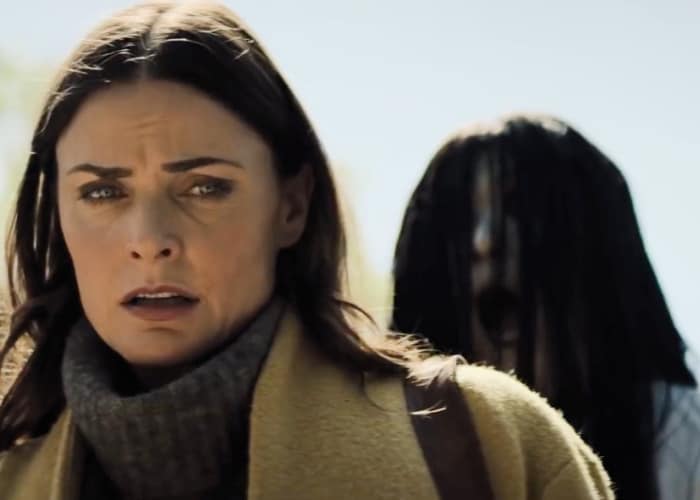
American movie studios love adapting Japanese horror films, illustrated again with Nicolas Pesce’s new iteration of The Grudge, or Ju-On as it is known in Japan. But these remakes typically pale in comparison to their predecessors. This is because they’re missing the crucial cultural context of the complex pantheon of spirits in Japanese folklore that plays an important role in shaping the nation’s history, art, and media. These spirits, known as yurei, take very specific forms, from giant skeletons called Gashadokuro to the mischievous and jolly raccoon-dog spirit the tanuki.
Further, there is a specific name for the wronged and vengeful female spirits so often seen in J-horror films and their subsequent adaptations. They are onryo, ghosts of women scorned who are dressed all in white with long black hair. These women have become the face of supernatural revenge, emphasizing the idea that women, while appearing demure or innocent, are capable of horrible things even in death. While there are more empowered readings to be made, they ultimately perpetuate the idea of female monstrosity and the fear of women. In her book Introduction to Japanese Horror Film, Colette Balmain said, “The reason for the success and ubiquity of such female ghosts is a mixture of female desire and fear of such empowerment.”
But this can apply to the use of any female ghost across national horror cinema. So how does it differ in Japan versus the United States? This again goes back to Japan’s centuries-long folkloric tradition that is still part of their everyday lives. The onryo and her revenge, particularly against men, is just as relevant today as it was centuries ago as women continue to be mistreated, beaten, and murdered by jealous husbands. Further, the Japanese are much more connected to their deceased family members, both in the act of mourning and celebrating them, than typically seen in the United States. There is a stronger connection between living and dead, which makes these ghosts of J-horror feel all the more real.
In specifically looking at the history of The Grudge films, the missteps and growing need to white-wash the story for American audiences becomes clear. The Ju-On franchise started in 2000 with the direct-to-video Ju-On: The Curse, directed by Takashi Shimizu. The film and its subsequent sequel became so well-regarded that a third installment was created for a theatrical run: 2004’s Ju-On: The Grudge. All of the films center on a house in Japan that is haunted by the ghosts of Kayako and her son, Toshio. Both were murdered by their husband/father after he suspected Kayako of infidelity. Shimizu based the story on the rising number of domestic violence cases in Japan. The film is based on the Japanese belief of a curse arising from a horrible wrong and is often seen as the manifestation of rage.
Japanese audiences understand and are familiar with the idea of ju-on, making the original film easy to understand for that demographic. However, as American audiences are not aware of the concept, Shimizu’s own 2004 American adaptation needed a lot more exposition and context. In an interview for Neo Mag, he said, “Since the Japanese audience already knows of the cultural background of ghosts, and many of the scary elements in the original movie…[they] did not find Ju-On as complicated as some of the American viewers – so we (had) to explain the story a bit more.”
This quote encapsulates the struggle of such adaptations; context is lost in translation. Shimizu himself faced that struggle as he worked to adapt his story into the 2004 American version of The Grudge. It is a fascinating middle ground as the story takes place in Japan, and Kayako is still the film’s villain, but the script is in English and the star is the well-known Sarah Michelle Gellar. Most of the characters are in fact Americans who have moved to Japan, which shifts the narrative to depict a Japanese spirit terrorizing and murdering Westerners. On top of that new layer of fear, this concept of ju-on must be spelled out for the audience. In trying to juggle the necessary amount of exposition and scares, The Grudge loses its focus and ultimately what made it so terrifying in the first place.
Pesce’s take on The Grudge, however, makes the vengeful ghost a white woman possessed by Kayako instead of keeping to the original portrayal of Kayako as an onryo. While placing the film in the United States with a white ghost removes potential criticism of appropriation of Japanese culture, it also begs the question of why even use the franchise name in the first place? The answer ultimately comes down to name recognition and the profit that can be earned from continuing a franchise instead of creating a unique narrative. This then becomes a form of imperialism as white studio executives take Japanese folklore for monetary gain; it is not about honoring the country, but about exploiting their history for profit.
Other instances of such adaptations, such as Ringu (The Ring), Dark Water, and Pulse, continue to display Western capitalistic desires of profiting off the work of East Asian countries without placing any consideration of the films’ cultural and historical context. While the adaptations remain ghost stories, they struggle, to varying degrees, to truly understand and convey the fear of the original Japanese films. Similar to the current discussion about dubbing English over films such as Parasite, this reflects the film industry’s assumed lack of interest or motivation to engage with a different culture’s texts. Instead, it just seems easier to Westernize them and make them white. In 2020, it is time to respect the works of non-Western directors, regardless of genre, and lift them up as crucial texts rather than ripping them off to fill seats.
Related Topics: The Grudge

